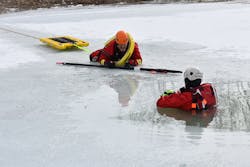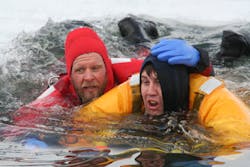Technical Rescue: It Isn’t an Ice Rescue Just Because There’s Ice
Consider this: It’s a cold, winter day on the local river. Duck season is underway. It has been extremely cold previously. The river appears to be frozen over. The day is gloomy, with a fair amount of fog present above the river. Visibility is poor.
A duck hunter is staged for the hunt; his eager dog is ready to do its job. At approximately 10 a.m., the duck hunter calls some ducks in and fires off a few rounds. He nails two. One of the ducks lands in the middle of the river on top of the ice. The duck hunter sends his dog to fetch the duck. His dog obediently goes onto the ice but promptly falls through. It barely holds onto the edge of the ice with its front paws.
The worried duck hunter goes to rescue his dog. In his attempt to rescue it, the duck hunter falls through the ice, too. The dog completely submerges and goes under the ice and into the moving water below. After about a 100-yard swim, the dog emerges downstream and is able to climb to shore. The duck hunter frantically begins to yell for help.
9-1-1 dispatch receives a call that there is a man in the icy river, desperately holding onto the ice. Local fire rescue is dispatched to the scene. Command immediately decides that this is an ice rescue incident, because there is ice present. Once the rescue technician is on scene and dressed in a hooded ice rescue suit, a tether line is connected to the standard issue harness that comes attached to the suit. The rescuer steps out onto the ice and begins to go toward the duck hunter. The rescuer slowly gets down onto his belly to disperse his weight on the unstable ice, crawling in military fashion. The rescuer gets to within 20 feet of the duck hunter and runs out of tether line. He decides to disconnect the tether line from the harness and continue toward the victim, who barely is hanging on to the fragile ice.
You might be wondering why the rescuer disconnects his tether line. If you ran out of tether line, what, if anything, could be done? What happens if the victim or the rescuer falls through the ice and travels in the moving water beneath the ice? What happens when the rescuer’s ice rescue suit floods. What is the plan once the untethered rescuer contacts the victim? Is the proper PPE being used for this incident? Ultimately, is this really an ice rescue operation or is it a swiftwater rescue operation?
What’s the difference between static ice rescue and moving ice rescue? Concerning rescuer safety, several components must be addressed, because static and moving water are completely different situations that require specific PPE, a standardized operational rescue response sequence and specialized victim care.
Ice rescue by definitions
The definition of static is lacking in movement, action or change. Static ice rescue response involves water that’s static. The top layer of the water is frozen, to what degree depends on numerous factors, including water temperature, ambient temperature, wind and, perhaps, bubblers.
Moving water is defined as changing the place or the position of water—hence, not stationary. Moving ice rescue response involves water that changes place or position. Often, we think of rivers as having moving water that’s constantly changing.
NFPA defines swiftwater as water that moves at a rate that’s faster than 1 knot (approximately 100 feet per minute).
An ice shelf is a large platform of ice that forms over a body of water that freezes; as the water level drops, a void is created under the ice. It’s common to have suspended ice shelfs present on a river as well as on a static body of water during the winter months.Proper PPE
The static ice rescue suit is buoyant, well insulated and water-resistant. It has attached boots, attached gloves and an attached hood. It comes equipped with ice awls and prebuilt storage pockets that can be accessed easily during the ice rescue. The suit typically comes in a standard “one-size-fits-most” size (from 5 feet tall to 6½ feet tall) and a size 12 boot.
Unfortunately, believing that a static ice suit accommodates the range of sizes that’s noted above is a mistake when it’s possible that a rescuer could end up in the water.
At incidents where it’s obvious that the ice is unstable and that it might be thin, and, thus, there’s a high probability of a rescuer breaking through, which size rescuer do you want on the ice? Your smallest and lightest rescue technician would be the best choice. Will the standard ice rescue suit fit your smallest and lightest technician? The answer probably is no. Therefore, the standard ice rescue suit is an impediment to the rescuer in this scenario.
Another factor in this vein is the hood. It’s supposed to be fully zipped past the neck. However, if the ice rescue suit is ill-fitting, the fully zipped hood might impede breathing, because it might go over the mouth—and, potentially, the nose—of your smallest and lightest rescuer. An ill-fitting hood also might impede the rescuer’s ability to hear commands from shore personnel or vital communication from the victim.
If the suit doesn’t fit nor have a watertight seal around the neck of the rescue technician, water will enter through the neck and flow down into the suit, potentially flooding the suit. This might be a limiting factor that’s manageable in a static ice rescue. However, we don’t promote the use of a static ice rescue suit in any moving water ice rescue or training exercise.
A better choice for moving ice operations is a surface dry suit. It typically is used during swiftwater operations. Surface dry suits have wrist seals, neck seals, and latex socks or attached boots. They are meant to keep a rescuer dry while adding warmth, provided that the technician wears thermals under the surface dry suit shell. A hood, gloves, a water-operations harness, a helmet and ice awls can be added. It’s mandatory to wear an approved personal flotation device (PFD) while using a surface dry suit in moving water operations.
Response considerations
You always should calculate risk vs. benefit with any operation, including risks to both rescue personnel and the victim. Ultimately, risk is minimized when rescue personnel aren’t put into a hazardous environment. Therefore, rescue professional always should look at an operation from a perspective of least amount of risk to greatest amount of risk.
Regardless of static ice operation or moving ice operation, the same low-risk-to-high-risk sequence applies. From lowest risk to highest risk, the first three methods are shore-based rescue operations. These include talk, reach and throw methods. With these three methods of rescue operation, the victim comes toward the shore-based rescue technician. The last two methods are highest risk: go/row and helicopter, where the rescue technician goes to the victim.The rescue sequence
Talk. Communication with the victim is an extremely important element that often is skipped. It helps to assess the condition of the victim and to evaluate whether rescue efforts are needed immediately. It also can calm the victim and help to get the individual’s breathing under control. Furthermore, it can reveal that the victim can self-rescue.
Reach. Offer the victim something from shore, such as a pole, stick or a ladder, to assist the victim with self-rescue efforts. Most victims aren’t buoyant, so try to get buoyancy to the individual. This could be a ring buoy, a cold-water rescue sling or a PFD.
Throw. Extend a helping hand by throwing a heaving line or a bag of rope, aka a throw bag. Such a device can help a victim get to the shore, to a boat or to a stable ice shelf. This might be all that’s required for victims to pull themselves out.
Go/row. Only when it’s decided that a victim can’t self-rescue and, thus, that assistance is required and that the rescuer must contact the victim should the rescuer go to the victim. The decision is based on numerous factors, including victim trauma, victim’s breathing and suspected hypothermia.
Reaching the victim might require the use of a boat (motorized or nonmotorized) or an ice rescue sled.
You must get buoyancy on the victim and help to assist the victim out of the hazardous environment and to ALS.
Helicopter. Using a helicopter puts all who are involved in the situation at the highest risk. Anytime that a mechanized or a mechanical system is introduced to a scene, chance of failure is increased. Of course, helicopters have many moving parts and require a high skill level to be flown in a rescue operation. Although we see many successful rescues, we also see crashes because of weather, unsafe terrain, mechanical issues and operator error.Victim care
Most of the time, an ice rescue response is time sensitive. The U.S. Coast Guard’s Cold Water Boot Camp USA states that when a human enters cold water, the individual has 10 minutes of meaningful movement and one hour before losing consciousness due to hypothermia. The only way that people can get to the one-hour mark is to have buoyancy that will support their head, which allows them to continue to breathe.
It’s important to recognize the signs and symptoms of hypothermia, which usually follow a common course, although gender, age, health and other factors play a role in how soon a person becomes hypothermic. Hypothermia might present mild to severe in degree. Each stage of suspected or confirmed hypothermia always should be treated with a very gentle approach.
Avoid rough handling and abrupt movements when providing care to hypothermic patients. Rough handling can put the victim into a state of ventricular fibrillation, which could cause heart arrhythmias and, thus, potentially death.
Rescuer risk, victim risk
An incident on a river that has ice present isn’t a static ice rescue response; it’s a swiftwater response.
A swiftwater rescue requires a rescuer to wear a surface dry suit. Special neck and wrist seals prevent water from entering the suit, thus providing protection against water flooding the suit.
Always work from low risk to high risk in the risk sequence and use the method that offers the greatest benefit while producing the least amount of risk to the rescuer and to the victim.
Always practice the KISS method: Keep It Simple and Safe.
About the Author

Bo Tibbetts
Bo Tibbetts is the full-time owner and water operations instructor for Public Safety Dive Services, a division of Technical Rescue International. He has been providing training services to public safety personnel for 17 years. Tibbetts is most noted with water operations, including surface ice rescue, swiftwater rescue, urban flood rescue, small boat operations, dive rescue and recovery operations. He has been instrumental in standardizing many water rescue industry standards and was accredited with numerous leading-edge ice rescue methodologies that are designed to keep rescue professionals safer. Tibbetts recently authored a segment of the second edition of the Water Rescue manual by Jones & Bartlett. He can be reached at [email protected].



